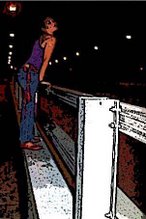When steel contacts water, an electrochemical process starts. On the surface of the metal, iron is oxidized to iron(II):
Fe -> Fe2+ + 2e-
The electrons released travel to the edges of the water droplet, where there is plenty of dissolved oxygen. They reduce the oxygen and water to hydroxide ions:
4e- + O2 + 2H2O -> 4OH-
The hydroxide ions react with the iron(II) ions and more dissolved oxygen to form iron oxide. The hydration is variable, however in its most general form:
Fe2+ + 2OH- -> Fe(OH)2
4Fe(OH)2 + O2 -> 2(Fe2O3.xH2O) + 2H2O
Hence, rust is iron(III)oxide, which is formed by the dehydration of iron(II) hydroxide. Corrosion tends to progress faster in seawater than fresh water due to higher concentration of sodium chloride ions, making the solution more conductive. Rusting is also accelerated in the presence of acids, but inhibited by alkalis, through passivation. Rust can often be removed through electrolysis, however the base metal object can not be restored through this method.
---
Ah yes, I'm being random again. But fear not...I'm just keeping restlessness at bay. The proposed Nalanda University sounds really promising - psychology, philosophy, and policies all in one place while firmly entrenched in Buddhist values and compassion. That's such a provoking thought.
Wednesday, November 22, 2006
Subscribe to:
Post Comments (Atom)

No comments:
Post a Comment